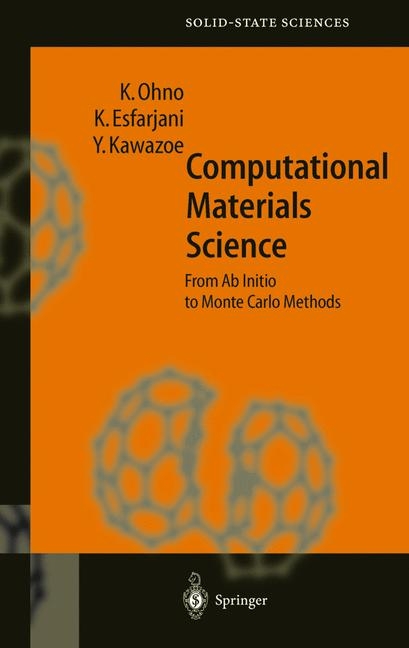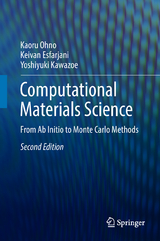
Computational Materials Science
Springer Berlin (Verlag)
978-3-540-63961-9 (ISBN)
- Titel erscheint in neuer Auflage
- Artikel merken
1. Introduction.- 1.1 Computer Simulation as a Tool for Materials Science.- 1.2 Modeling of Natural Phenomena.- 2. Ab Initio Methods.- 2.1 Introduction.- 2.2 Electronic States of Many-Particle Systems.- 2.2.1 Quantum Mechanics of Identical Particles.- 2.2.2 The Hartree-Fock Approximation.- 2.2.3 Density Functional Theory.- 2.2.4 Periodic Systems.- 2.2.5 Group Theory.- 2.2.6 LCAO, OPW and Mixed-Basis Approaches.- 2.2.7 Pseudopotential Approach.- 2.2.8 APW Method.- 2.2.9 KKR, LMTO and ASW Methods.- 2.2.10 Some General Remarks.- 2.2.11 Ab Initio O(N) and Related Methods.- 2.3 Perturbation and Linear Response.- 2.3.1 Effective-Mass Tensor.- 2.3.2 Dielectric Response.- 2.3.3 Magnetic Susceptibility.- 2.3.4 Chemical Shift.- 2.3.5 Phonon Spectrum.- 2.3.6 Electrical Conductivity.- 2.4 Ab Initio Molecular Dynamics.- 2.4.1 Car-Parrinello Method.- 2.4.2 Steepest Descent and Conjugate Gradient Methods.- 2.4.3 Formulation with Plane Wave Basis.- 2.4.4 Formulation with Other Bases.- 2.5 Applications.- 2.5.1 Application to Fullerene Systems.- 2.5.2 Application to Point Defects in Crystals.- 2.5.3 Application to Other Systems.- 2.5.4 Coherent Potential Approximation.- 2.6 Beyond the Born-Oppenheimer Approximation.- 2.7 Electron Correlations Beyond the LDA.- 2.7.1 Generalized Gradient Approximation.- 2.7.2 Self-Interaction Correction.- 2.7.3 GW Approximation.- 2.7.4 Exchange and Coulomb Holes.- 2.7.5 Optimized Effective Potential Method.- 2.7.6 Time-Dependent Density Functional Theory.- 2.7.7 Inclusion of Ladder Diagrams.- 2.7.8 Further Remarks: Cusp Condition, etc.- References.- 3. Tight-Binding Methods.- 3.1 Introduction.- 3.2 Tight-Binding Formalism.- 3.2.1 Tight-Binding Parametrization.- 3.2.2 Calculation of the Matrix Elements.- 3.2.3 Total Energy.- 3.2.4 Forces.- 3.3 Methods to Solve the Schrödinger Equation for Large Systems.- 3.3.1 The Density Matrix O(N) Method.- 3.3.2 The Recursion Method.- 3.4 Self-Consistent Tight-Binding Formalism.- 3.4.1 Parametrization of the Coulomb Integral U.- 3.5 Applications to Fullerenes, Silicon and Transition-Metal Clusters.- 3.5.1 Fullerene Collisions.- 3.5.2 C240 Doughnuts and Their Vibrational Properties.- 3.5.3 IR Spectra of C60 and C60 Dimers.- 3.5.4 Simulated Annealing of Small Silicon Clusters.- 3.5.5 Titanium and Copper Clusters.- 3.6 Conclusions.- References.- 4. Empirical Methods and Coarse-Graining.- 4.1 Introduction.- 4.2 Reduction to Classical Potentials.- 4.2.1 Polar Systems.- 4.2.2 Van der Waals Potential.- 4.2.3 Potential for Covalent Bonds.- 4.2.4 Embedded-Atom Potential.- 4.3 The Connolly-Williams Approximation.- 4.3.1 Lattice Gas Model.- 4.3.2 The Connolly-Williams Approximation.- 4.4 Potential Renormalization.- 4.4.1 Basic Idea: Two-Step Renormalization Scheme.- 4.4.2 The First Step.- 4.4.3 The Second Step.- 4.4.4 Application to Si.- References.- 5. Monte Carlo Methods.- 5.1 Introduction.- 5.2 Basis of the Monte Carlo Method.- 5.2.1 Stochastic Processes.- 5.2.2 Markov Process.- 5.2.3 Ergodicity.- 5.3 Algorithms for Monte Carlo Simulation.- 5.3.1 Random Numbers.- 5.3.2 Simple Sampling Technique.- 5.3.3 Importance Sampling Technique.- 5.3.4 General Comments on Dynamic Models.- 5.4 Applications.- 5.4.1 Systems of Classical Particles.- 5.4.2 Modified Monte Carlo Techniques.- 5.4.3 Percolation.- 5.4.4 Polymer Systems.- 5.4.5 Classical Spin Systems.- 5.4.6 Nucleation.- 5.4.7 Crystal Growth.- 5.4.8 Fractal Systems.- References.- 6. Quantum Monte Carlo (QMC) Methods.- 6.1 Introduction.- 6.2 Variational Monte Carlo (VMC) Method.- 6.3 Diffusion Monte Carlo (DMC) Method.- 6.4 Path-Integral Monte Carlo (PIMC) Method.- 6.5 Quantum Spin Models.- 6.6 Other Quantum Monte Carlo Methods.- References.- A. Molecular Dynamics and Mechanical Properties.- A.l Time Evolution of Atomic Positions.- A.2 Acceleration of Force Calculations.- A.2.1 Particle-Mesh Method.- A.2.2 The Greengard-Rockhlin Method.- References.- B. Vibrational Properties.- References.- C. Calculation of the Ewald Sum.- References.- D. Optimization Methods Used in Materials Science.- D.l Conjugate-Gradient Minimization.- D.2 Broyden’s Method.- D.3 SA and GA as Global Optimization Methods.- D.3.1 Simulated Annealing (SA).- D.3.2 Genetic Algorithm (GA).- References.
| Erscheint lt. Verlag | 18.8.1999 |
|---|---|
| Reihe/Serie | Springer Series in Solid-State Sciences ; 129 |
| Zusatzinfo | X, 329 p. |
| Verlagsort | Berlin |
| Sprache | englisch |
| Maße | 155 x 235 mm |
| Gewicht | 620 g |
| Themenwelt | Naturwissenschaften ► Physik / Astronomie ► Allgemeines / Lexika |
| Schlagworte | algorithms • computer simulation • Materialeigenschaften • Mathematische Physik • Model • Modeling • Monte Carlo • Monte Carlo simulation • Optimization • Potential • Simulation |
| ISBN-10 | 3-540-63961-6 / 3540639616 |
| ISBN-13 | 978-3-540-63961-9 / 9783540639619 |
| Zustand | Neuware |
| Haben Sie eine Frage zum Produkt? |
aus dem Bereich



